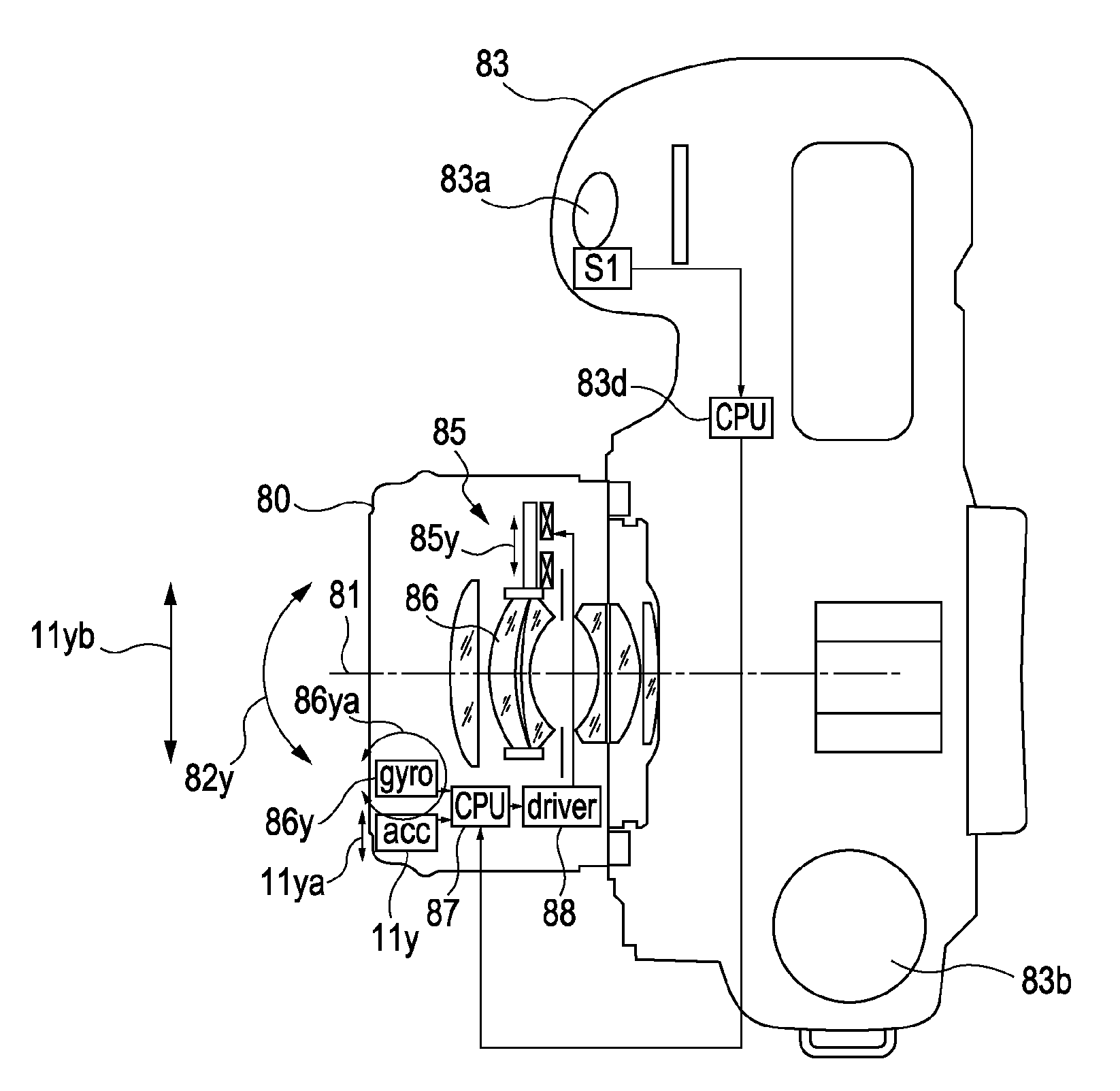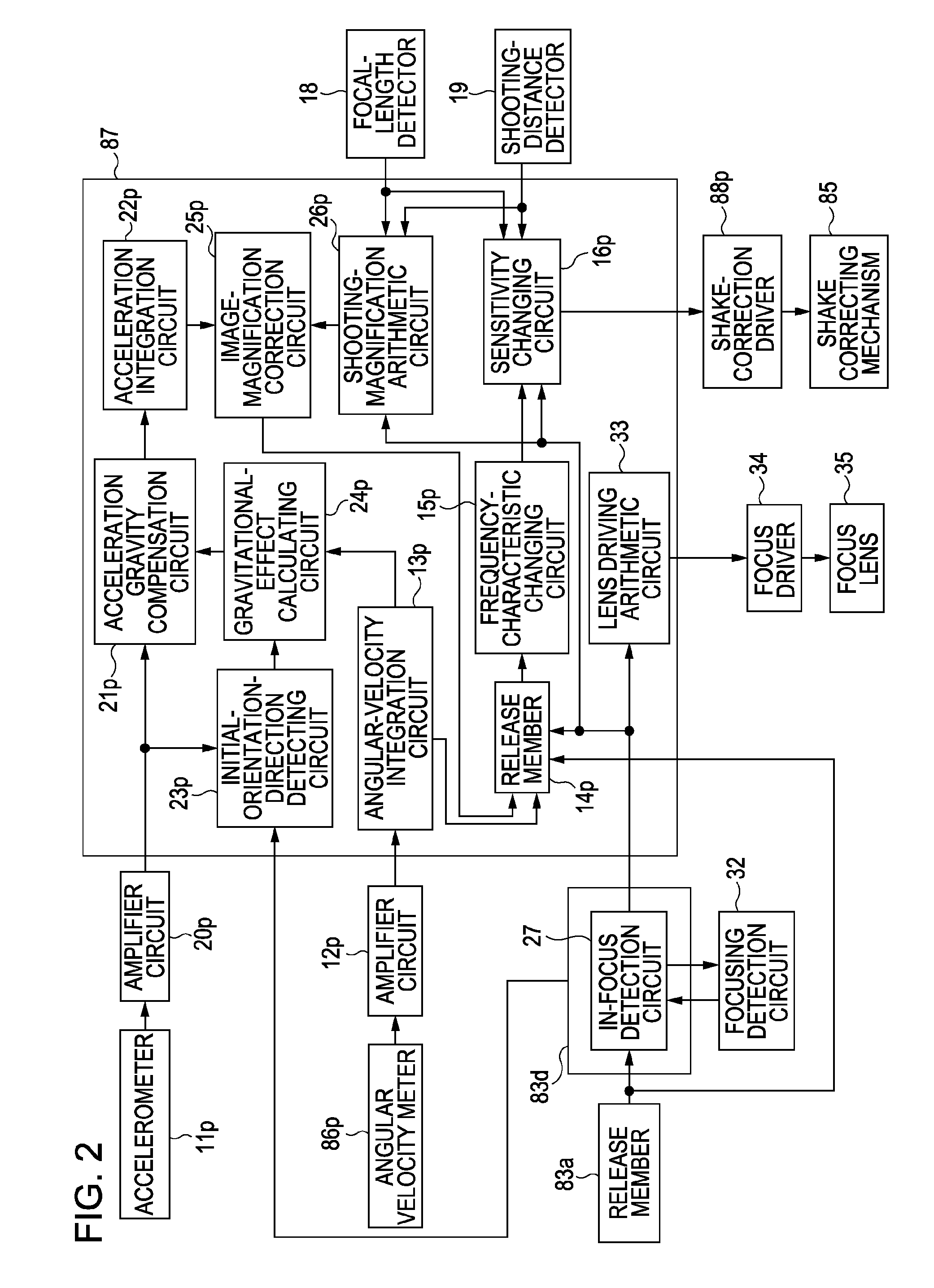Image stabilizing system and optical apparatus
- Summary
- Abstract
- Description
- Claims
- Application Information
AI Technical Summary
Benefits of technology
Problems solved by technology
Method used
Image
Examples
first embodiment
[0032]FIGS. 1A and 1B are a cross-sectional plan view and a cross-sectional side view of a single-lens reflex camera according to a first embodiment of the present invention. The single-lens reflex camera of the first embodiment of the invention differs from that of the related art shown in FIGS. 9A and 9B in having accelerometers 11p and 11y. The acceleration detection axes of the accelerometers 11p and 11y are aligned with the arrows 11pa and 11ya shown in FIGS. 1A and 1B. The arrows 11pb and 11yb indicate shift shake in the corresponding directions.
[0033]FIG. 2 is a block diagram that includes a circuit that processes signals of shift shake detected by the accelerometers 11p and 11y and signals of rotational shake detected by angular velocity meters 86p and 86y. The processing of these signals is implemented within a lens microcomputer (CPU) 87. FIG. 2 only shows signal processing for alleviating image shake caused by pitch shake of the camera (i.e. rotational shake corresponding...
second embodiment
[0080]A single-lens reflex camera according to a second embodiment of the present invention will now be described. The second embodiment differs from the first embodiment in FIG. 5 in that the rotational shake correction is started upon half-pressing of the release member 83a, that is, when the switch S1 is turned on, and that the shift shake correction is performed in an exposure process (when the release member 83a is fully pressed, that is, when a switch S2 is turned on). Other mechanical and electrical configurations of the camera in the second embodiment are the same as those in the first embodiment.
[0081]FIG. 6 is a flow chart of an operation for performing image-shake correction according to the second embodiment of the present invention. This operation starts when the main power switch of the camera is turned on. The steps performed in this operation that correspond to those in the operation of the first embodiment shown in FIG. 5 are given the same step numbers. Similar to ...
third embodiment
[0090]A single-lens reflex camera according to a third embodiment of the present invention will now be described. The third embodiment differs from the second embodiment in that the rotational shake correction is started when the main power switch of the camera is turned on (that is, in response to activation of the camera), and that the shift shake correction is performed upon half-pressing of the release member 83a, that is, when the switch S1 is turned on. Other mechanical and electrical configurations of the camera in the third embodiment are the same as those in the first and second embodiments.
[0091]FIG. 7 is a flow chart of an operation for performing image-shake correction according to the third embodiment of the present invention. This operation starts when the main power switch of the camera is turned on. The steps performed in this operation that correspond to those in the operations of the first and second embodiments shown in FIGS. 5 and 6 are given the same step number...
PUM
 Login to View More
Login to View More Abstract
Description
Claims
Application Information
 Login to View More
Login to View More - R&D
- Intellectual Property
- Life Sciences
- Materials
- Tech Scout
- Unparalleled Data Quality
- Higher Quality Content
- 60% Fewer Hallucinations
Browse by: Latest US Patents, China's latest patents, Technical Efficacy Thesaurus, Application Domain, Technology Topic, Popular Technical Reports.
© 2025 PatSnap. All rights reserved.Legal|Privacy policy|Modern Slavery Act Transparency Statement|Sitemap|About US| Contact US: help@patsnap.com



